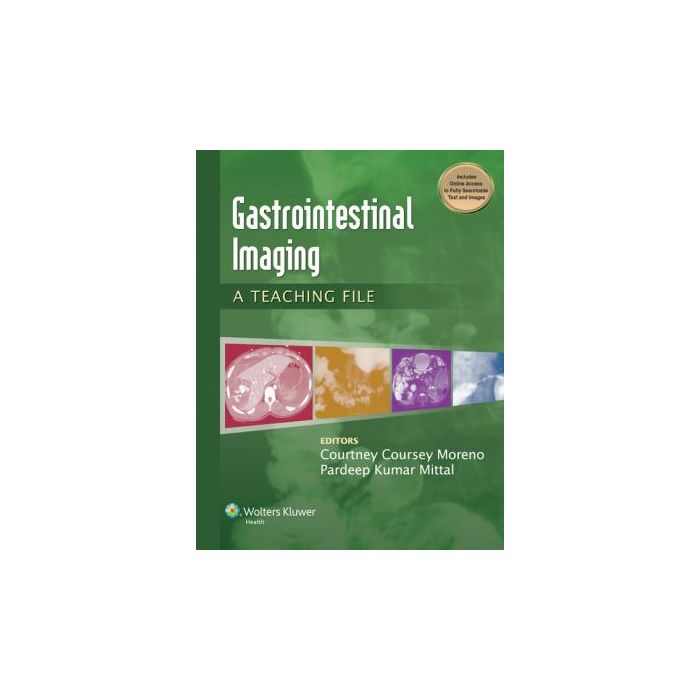Gastrointestinal Imaging. A Teaching File [Moreno - LIPPINCOTT Williams and Wilkins]

- ISBN/EAN
- 9781451173376
- Editore
- LIPPINCOTT Williams and Wilkins
- Formato
- Brossura
- Anno
- 2014
- Pagine
- 208
Disponibile
57,00 €
A brand new resource in The Teaching Files series, Gastrointestinal Imaging: A Teaching File is an exceptional resource for radiology trainees and practicing radiologists who are interested in reviewing the basics of gastrointestinal imaging, including fluoroscopy, CT, and MR. Those studying for board and certifying examinations will also find this volume to be an excellent reference in helping them to review and prepare for these tests.
Maggiori Informazioni
| Autore | Moreno Courtney Coursey; Mittal Pardeep Kumar |
|---|---|
| Editore | LIPPINCOTT Williams and Wilkins |
| Anno | 2014 |
| Tipologia | Libro |
| Lingua | Inglese |
| Indice | CASE 1.1: Achalasia 2 CASE 1.2: Varices 4 CASE 1.3: Sliding hiatal hernia 6 CASE 1.4: Paraesophageal hernia 8 CASE 1.5: Neoplasm (adenocarcinoma) 10 CASE 1.6: Neoplasm (adenocarcinoma) 12 CASE 1.7: Barrett esophagus 14 CASE 1.8: Candida esophagitis 16 CASE 1.9: Boerhaave syndrome 17 CASE 1.10: CMV ulcer 19 CASE 1.11: Extrinsic compression on esophagus due to aberrant left subclavian artery, also right-sided aortic arch 20 CASE 1.12: Fibrovascular polyps 22 CASE 1.13: Submucosal mass (granular cell tumor) 23 CASE 1.14: Long-segment esophageal stricture 25 CASE 1.15: Zenker diverticulum 27 CASE 1.16: Intramural pseudodiverticulosis 29 CASE 1.17: Candidiasis 31 CASE 1.18: Gastric adenocarcinoma 33 CASE 1.19: Adjustable gastric band 35 CASE 1.20: Slipped gastric band 37 CASE 1.21: Eroded gastric band 39 CASE 1.22: Roux-en-y gastric bypass 41 CASE 1.23: Stomal stenosis AND marginal ulcer 43 CASE 1.24: Status post sleeve gastrectomy 44 CASE 1.25: Slipped fundoplication 46 CASE 1.26: Submucosal mass (GIST at biopsy) 48 CASE 1.27: Ulcer 50 CASE 1.28: Gastric adenocarcinoma 51 CASE 1.29: Organoaxial volvulus 52 CASE 1.30: Polyps 53 CASE 1.31: Bezoar 55 CASE 1.32: Linitis plastica appearance of the stomach due to gastric cancer 56 CASE 1.33: Metastatic disease (metastatic melanoma) 57 CASE 1.34: Submucosal mass (lipoma) 58 CASE 1.35: Metastatic disease (melanoma) 59 CASE 1.36: Diverticula 61 CASE 1.37: Scleroderma 63 CASE 1.38: Graft-versus-host disease (GVHD) 65 CASE 1.39: Parasite infection (ascariasis) 67 CASE 1.40: Whipple disease 69 CASE 1.41: Celiac disease 71 CASE 1.42: Delayed diagnosis of Hirschsprung disease 73 CASE 1.43: Rectal cancer 75 CASE 1.44: Adenomatous polyp 76 CASE 1.45: Extrinsic compression due to endometriosis 77 CASE 1.46: Polyp 79 CASE 1.47: Adenocarcinoma 80 CASE 1.48: Sigmoid volvulus 81NDIX CASE 1.49: Pseudopolyps due to ulcerative colitis 83 CASE 1.50: FAP 85 CASE 1.51: Adenocarcinoma in the setting of ulcerative colitis 86 CASE 2.1: Abscesses 90 CASE 2.2: Hydatid cysts 91 CASE 2.3: Biliary cystadenoma 93 CASE 2.4: SVC occlusion 95 CASE 2.5: Hepatocellular adenoma 97 CASE 2.6: Abscess 100 CASE 2.7: Hepatocellular cancer with tumor thrombus in the right hepatic vein extending into the IVC 102 CASE 2.8: Metastatic carcinoid tumor 104 CASE 2.9: RPC 106 CASE 2.10: Bile duct leak 109 CASE 2.11: Dropped gallstone 111 CASE 2.12: Pancreatic cystosis associated with cystic fibrosis 112 CASE 2.13: Intrapancreatic splenule 114 CASE 2.14: Autoinfarcted spleen in the setting of sickle cell disease 117 CASE 2.15: Delayed splenic rupture 119 CASE 2.16: GIST 120 CASE 2.17: Adenocarcinoma 121 CASE 2.18: Aortoenteric fistula 123 CASE 2.19: Meckel diverticulitis 124 CASE 2.20: Gallstone ileus 125 CASE 2.21: Ischemic enteritis related to systemic lupus erythematosus (SLE) 127 CASE 2.22: Angiotensin-converting enzyme (ACE) inhibitor-induced angioedema of small bowel 129 CASE 2.23: Acute appendicitis 132 CASE 2.24: Active bleeding 133 CASE 2.25: Colonic injury with adjacent mesenteric hematoma 136 CASE 2.26: Complicated diverticulitis with colovesical fistula 137 CASE 2.27: Retained foreign body (blue surgical towel), also known as a gossypiboma 139 CASE 3.1: Hepatocellular carcinoma 142 CASE 3.2: Budd-Chiari syndrome 144 CASE 3.3: FNH 146 CASE 3.4: Hepatocellular carcinoma 148 CASE 3.5: Intrahepatic cholangiocarcinoma 151 CASE 3.6: Lymphoma (secondary, non-Hodgkin) 153 CASE 3.7: Polycystic liver disease associated with autosomal- dominant polycystic kidney disease (ADPCKD) 155 CASE 3.8: Hemangioma 157 CASE 3.9: Hepatic steatosis with fat sparing 159 CASE 3.10: Confluent hepatic fibrosis 161 CASE 3.11: PTLD 163 CASE 3.12: Gallstones 165 CASE 3.13: Cholangiocarcinoma 167 CASE 3.14: Ischemic cholangiopathy; also intraductal stones and sludge due to stasis 169 CASE 3.15: Adenomyomatosis 171 CASE 3.16: Contained remote prior gallbladder perforation 173 CASE 3.17: SPT of the pancreas 175 CASE 3.18: Autoimmune pancreatitis 177 CASE 3.19: Acute appendicitis 179 CASE 3.20: Appendiceal mucocele due to mucinous cystadenoma 181 CASE 3.21: T4 rectal cancer 183 CASE 3.22: Desmoid tumor 184 |
Questo libro è anche in:
